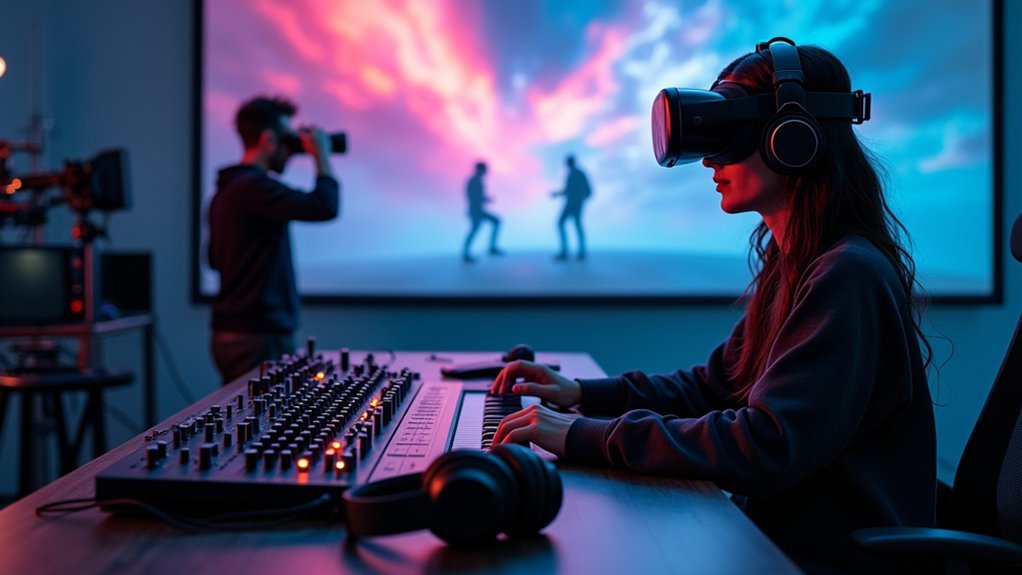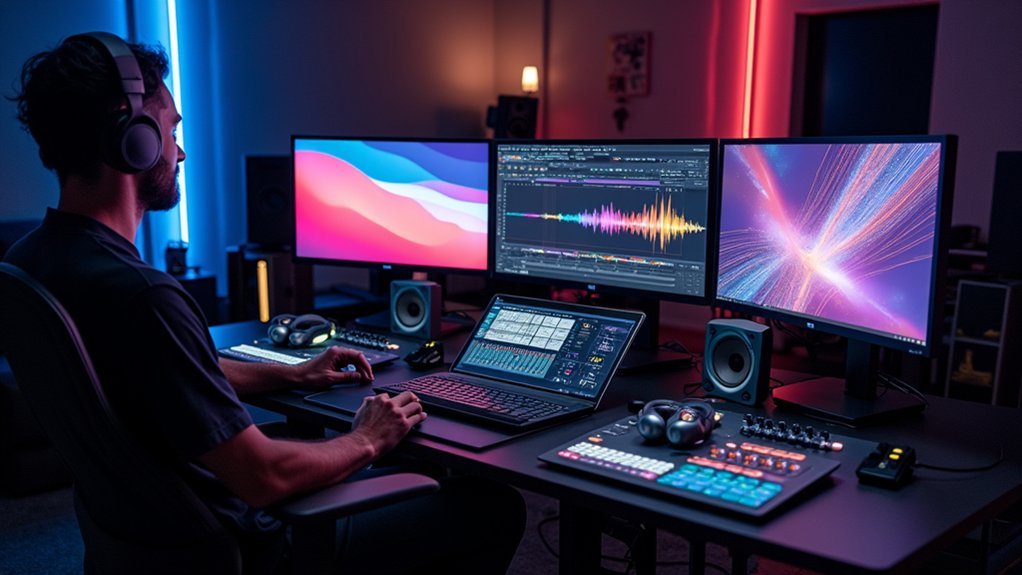You’ll need ambisonic microphones like the Sennheiser AMBEO VR Mic to capture 360-degree soundfields, plus specialized DAWs such as Reaper or Pro Tools with ambisonic capabilities. Position your microphones close to the camera for proper audio-visual alignment, then apply HRTFs during post-production to enhance 3D localization. Mix your spatial audio layers in Ambix format, test across multiple VR headsets, and guarantee platform compatibility for distribution. The techniques below will transform your VR storytelling completely.
Understanding Spatial Audio Technologies for VR Filmmaking

When creating VR films, you’ll find that traditional stereo audio falls short of delivering the immersive experience viewers expect from virtual reality.
Spatial audio technologies transform how audiences perceive sound in VR environments, making them essential for compelling storytelling.
Binaural recording uses Head-Related Transfer Functions to deliver distinct audio to each ear, creating natural three-dimensional hearing.
You’ll capture realistic soundscapes that respond to viewer head movements, enhancing presence within your virtual world.
Ambisonics offers another powerful approach, using spherical microphone arrays to record full-sphere soundfields.
This technique provides complete directional control during post-production, letting you craft immersive soundscapes with precision.
Object-based audio gives you maximum flexibility by treating individual sounds as discrete 3D elements.
You can position effects, dialogue, and music anywhere in virtual space, creating dynamic audio that adapts to viewer interactions in real-time.
Essential Equipment and Software for Capturing VR Audio
While understanding spatial audio technologies provides the foundation for VR filmmaking, you’ll need specialized equipment and software to capture professional-quality immersive soundscapes.
Professional VR filmmaking demands specialized spatial audio equipment and software to create truly immersive soundscapes that captivate audiences.
For your immersive audio experience, you’ll want high-quality ambisonic microphones like the Sennheiser AMBEO VR Mic, which captures sound from all directions for complete soundfield recording. Place these microphones near your camera, balancing ambient noise with clear sound sources.
Your spatial audio tools should include:
- Audio middleware supporting B-format with real-time decoders for seamless ambisonic integration
- Digital audio workstation like Reaper or Pro Tools with ambisonic handling capabilities and spatial manipulation plugins
- Head-related transfer functions (HRTFs) during mixing to simulate realistic sound interaction with human anatomy
This combination guarantees you’ll create convincing VR audio that responds naturally to viewer head movements and positioning.
Recording Techniques Using Ambisonic Microphones and Binaural Methods

You’ll need to master proper Ambisonic microphone placement to capture the full 360-degree soundscape that makes VR films truly immersive.
Position your Ambisonic mic close to your camera setup to minimize audio degradation and guarantee the spatial audio aligns perfectly with your visual content.
Consider incorporating binaural recording methods alongside your Ambisonic setup to create layered audio experiences that translate exceptionally well to headphone-based VR viewing.
Ambisonic Microphone Setup
Four channels of audio capture transform traditional filmmaking into an immersive three-dimensional soundscape through first-order ambisonic microphones.
These specialized devices record sound from every direction, creating the spatial audio foundation necessary for compelling immersive experiences in VR films.
Your ambisonic microphone placement requires strategic positioning to maximize recording quality:
- Position near the camera – Place your microphone close to the visual capturing device to guarantee audio-visual alignment matches the viewer’s perspective.
- Consider acoustic environment – Account for reflective surfaces that can distort the captured sound field and compromise spatial accuracy.
- Isolate from interference – Implement sound isolation strategies to prevent unwanted noise from contaminating your full-sphere audio recording.
Proper setup enables you to capture the complete soundfield that’ll transport viewers directly into your virtual environment.
Binaural Recording Methods
Beyond ambisonic capture, binaural recording methods offer an alternative approach that mimics natural human hearing through specialized dummy head microphones.
You’ll achieve realistic and immersive audio experiences by positioning these microphones to replicate how sound reaches human ears. This technique creates three-dimensional soundscapes that feel natural when listeners use headphones.
To enhance your binaural recordings, you can apply Head-Related Transfer Functions (HRTFs) during post-production.
These functions simulate how sound waves interact with a listener’s head and ears, considerably improving localization accuracy. HRTFs help your audience pinpoint exactly where sounds originate in the virtual environment.
While binaural recording methods excel at creating intimate, headphone-optimized experiences, they work best when you want to provide viewers with a fixed listening perspective rather than dynamic spatial manipulation capabilities.
Audio Capture Positioning
When positioning your audio capture equipment, strategic placement becomes the foundation for creating convincing spatial audio in VR films. Your audio capture positioning directly impacts the immersive sound experience you’ll deliver to viewers.
Place your Ambisonic microphone as close to your camera as possible. This guarantees perfect audio-visual alignment, creating seamless spatial relationships between what viewers see and hear.
Here’s how to optimize your recording setup:
- Position Ambisonic mics near the camera for accurate directional sound matching
- Use binaural dummy head techniques to replicate natural human ear perception
- Record ambient sounds separately from primary dialogue and sound sources
You’ll want to combine surround and mono recordings to create diverse audio layers. This approach gives you maximum control during post-production, allowing precise mixing that balances environmental soundscapes with critical dialogue elements.
Post-Production Workflow for Spatial Audio in VR Films

Once you’ve captured your ambisonic audio, you’ll need to sync it with your 360° footage and begin the critical process of mixing spatial audio layers in your DAW.
You’ll then apply immersive audio effects that respond to viewer movements, creating dynamic soundscapes that shift based on head orientation.
Finally, you’ll export your project using proper encoding formats like Ambix to guarantee compatibility across VR platforms and devices.
Mixing Spatial Audio Layers
As you shift into post-production, mixing spatial audio layers becomes the foundation for creating truly immersive VR experiences that transport viewers into your film’s world.
Your ambisonic microphones have captured rich immersive soundscapes, and now it’s time to craft them into a cohesive audio environment.
Here’s your mixing workflow:
- Load ambisonic plugins in your DAW to manipulate and position sounds in 3D space, giving you precise control over audio placement.
- Balance ambient sounds with primary audio sources while adding reverb effects to simulate realistic environmental acoustics.
- Test your mix across both headphone and multi-speaker setups to verify consistent spatial audio fidelity.
Finally, encode your finished mix in Ambix format for maximum VR platform compatibility and peak immersive impact.
Applying Immersive Audio Effects
With your spatial mix properly balanced, you’ll enhance the immersive experience by applying targeted audio effects that respond to the viewer’s movement and position within the virtual environment.
Layer ambient sounds with dialogue using reverb and panning techniques to create depth and clarity in your audio landscape. These sound design strategies guarantee viewers feel completely immersed in the virtual world.
Utilize your DAW’s ambisonic plugins to manipulate and position effects precisely in 3D space. Apply distance-based attenuation, directional filters, and environmental reverb that changes based on the viewer’s location.
Test these effects thoroughly using both headphones and multi-speaker setups to verify your spatial audio translates effectively across different playback systems, maintaining the intended immersive experience regardless of the viewer’s hardware configuration.
Export and Platform Encoding
After finalizing your spatial audio effects, you’ll need to export your mix in formats that VR platforms can properly decode and spatialize.
Your choice of spatial audio formats directly impacts how users experience your content across different devices.
Follow these essential steps for best results:
- Choose compatible formats – Export in Ambisonics or binaural stereo to guarantee broad platform support.
- Include proper metadata – Encode detailed information about your spatial audio format and track layout so VR systems recognize your files correctly.
- Test across playback systems – Verify your audio translates well on headphones and multi-speaker setups before final delivery.
Export as high-quality WAV or FLAC files first, then encode for specific platforms like Oculus or SteamVR based on their unique requirements.
Mixing and Positioning Audio Objects in Three-Dimensional Space
Everything about your VR film’s immersive quality hinges on how effectively you position and mix audio objects within three-dimensional space.
You’ll need to utilize object-based audio techniques that place individual sound sources precisely in your virtual environment, creating dynamic and interactive listening experiences for viewers.
Implement Head-Related Transfer Functions (HRTFs) to simulate how sound reaches each ear differently. This enhances perception of directionality and distance in your spatial audio mix.
HRTFs replicate natural hearing by creating distinct audio pathways to each ear, delivering precise spatial positioning that makes virtual sounds feel authentically three-dimensional.
Choose a Digital Audio Workstation like Audiocube that supports spatial audio manipulation within virtual 3D environments.
Experiment with sound layers by adjusting levels and effects like reverb to create realistic depth.
Regularly test your mixing across both headphone and speaker setups, ensuring spatial audio translates effectively while maintaining clarity and immersive quality throughout different playback systems.
Testing and Optimizing Audio for Different VR Headsets
Since each VR headset processes audio differently, you’ll need to test your spatial audio mix across multiple devices to confirm consistent quality and immersion.
Testing audio requires evaluation in both headphone and speaker configurations to ascertain compatibility across various playback systems.
Here’s your optimization workflow:
- Format compatibility check – Verify your audio works with each device’s supported formats like binaural or ambisonics, encoding in compatible formats such as Ambix for first-order ambisonics.
- Real-time monitoring – Use monitoring tools to assess how sound positioning and effects translate during head tracking and movement.
- User testing sessions – Conduct listening tests with diverse users to gather feedback on localization accuracy and overall audio performance.
This systematic approach guarantees your spatial audio delivers consistent immersive experiences across all target VR headsets.
Distribution and Platform Considerations for VR Films With Spatial Audio
Once you’ve perfected your spatial audio across devices, choosing the right distribution platform becomes your next priority.
You’ll need to encode your VR film in compatible formats like Ambisonics or object-based audio to guarantee immersive sound experiences translate properly across platforms.
Focus on distribution platforms that fully support spatial audio, including Oculus Store, Steam, and YouTube VR, as these reach audiences with capable rendering devices.
Choose platforms like Oculus Store, Steam, and YouTube VR that fully support spatial audio for maximum audience reach.
Don’t forget to include detailed metadata specifying your spatial audio format—this facilitates proper playback and enhances user experience.
Test your film across different playback systems, from headphones to multi-speaker setups, guaranteeing consistent quality.
Consider middleware solutions that enable dynamic sound positioning based on user interactions, making your spatial audio responsive to viewer movements.
Frequently Asked Questions
How to Create Immersive Audio?
You’ll create immersive audio by using ambisonic recording techniques, implementing HRTFs for realistic ear perception, positioning sounds dynamically in 3D space, mixing high-quality layers with effects, and utilizing spatial audio plugins.
What Is the Difference Between Spatial Audio and Immersive Audio?
You’ll find spatial audio focuses on positioning sounds directionally around you using technical algorithms, while immersive audio creates an all-encompassing experience that surrounds you completely from every angle.
Does Spatial Audio Work With Movies?
You’ll find spatial audio works excellently with movies, creating three-dimensional soundscapes that enhance your viewing experience. It’s supported by major streaming platforms and greatly improves immersion in both traditional and VR films.
How to Make Your Own Spatial Audio?
You’ll create spatial audio by using DAWs like Audiocube with 3D positioning plugins, experimenting with binaural recording techniques, implementing ambisonic microphones, leveraging object-based technologies like Dolby Atmos, and monitoring across different playback systems.
In Summary
You’ve now got the foundation to craft compelling VR films that truly transport audiences. Don’t underestimate spatial audio’s power—it’s what transforms good VR into unforgettable experiences. Start experimenting with ambisonic recording, master your post-production workflow, and always test across multiple headsets. Remember, you’re not just making a film; you’re building worlds where viewers can lose themselves completely. Your audience will feel the difference when audio and visuals work in perfect harmony.





Leave a Reply